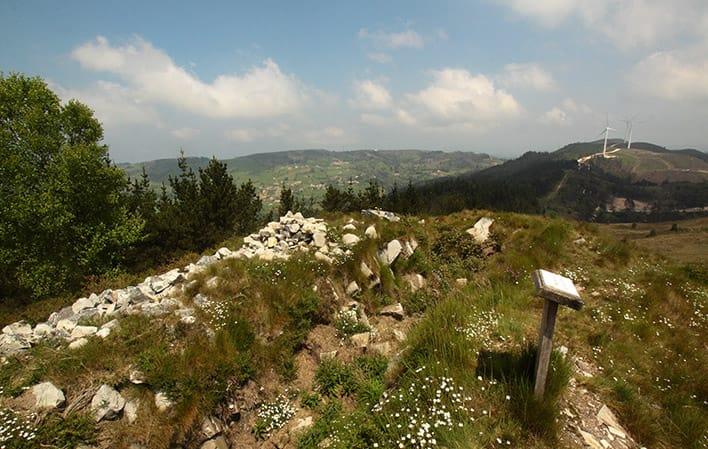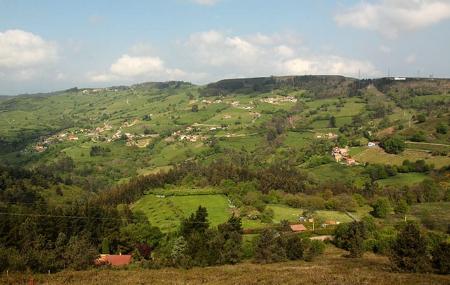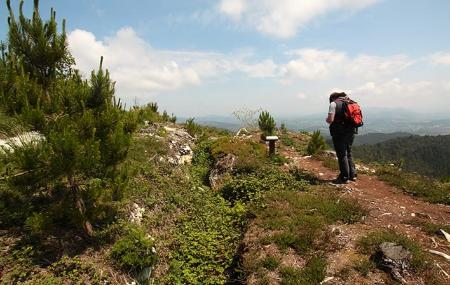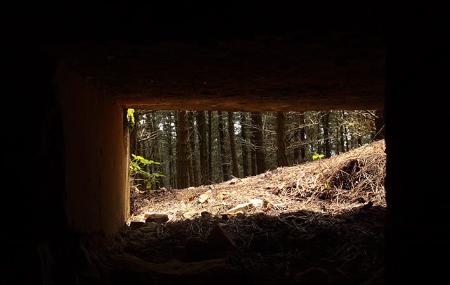
Nalon Front Route
- Address Candamo Asturias Centre
- Distance Distance: 14 kms
- Difficulty Difficulty: Half
- Altitude Altitude: 613 m.
- Unevenness Unevenness: 568 m.
-
On foot
On foot:
4 h.
One way
- Start point Start point: Alto de la Sierra
- Route type Route type: Hiking
- Tour type Tour type: Round trip
- Layout of the route Layout of the route: Download kml, Download kmz
Info
Perhaps one of the deepest traces that human beings can leave is that of a war, and this can also be imprinted on nature. This route reminds us of the conflict that pitted brothers against brothers in the last century and the vestiges it left behind.
Trenches hundreds of metres long, machine gun nests, small bunkers, in a total of fifteen kilometres, divided into three sections, from where they controlled the nearby valleys.
Pine forests and thickets of heather and gorse occupy a large part of the landscape, recreational areas where we can sit down to eat and open landscapes to dominate from the heights are some of the resources offered by this route, where we can also enjoy the flight of some birds of prey.
A route that gives us a historical view of the surroundings while we enjoy nature, with the tracks of roe deer, the landscape carved out by the water and the rich orchards of Candamo, which we find when we reach the populated areas.
Route
Alto de la Sierra - Villar 15
The Frente del Nalón route is made up of three different routes, which can be done separately or together, as where one ends and the other begins; it is up to each person's taste. This is a historical area, that of the Spanish Civil War, where we can see trenches from 1937.
Front of the Nalón section 1: This first section is circular and has a length of 5 kilometres. It starts from the car park at the top of the Sierra - the path is well signposted - and climbs up the Candamo slope on a path through the forest. During the walk you can see machine gun nests, observatories, trenches... all accompanied by the corresponding explanatory signs.
About 500 metres from the start, on the left hand side, we find the sentry blockhouse of Los Cuetos, the first of the fortified positions. When you reach the first kilometre, go uphill to the right and a little further on, about 200 metres further on, turn right again.
The path turns sharply upwards at kilometre 1.4, and 200 metres further on, following the path, we will find new fortified positions, the trenches of Las Fontes, which covered the road from Grullos to Avilés, of great strategic value as the main communication route in the area.
After leaving Las Fontes behind, we continue ascending on the left, and at kilometre 3 we find the La Llinar trench, located in the Altu de La Llinar, which divides the municipalities of Candamo, Las Regueras and Illas, and from which we can also observe the presence of an ancient Neolithic burial mound. This large trench controlled the Cogollu valley in Las Regueras.
We descend the ridge to head back to the car park, the end of this first stage, but at kilometre 4.4 of our route we will find yet another defensive element, a large trench excavated in the rock in the place known as Pie de la Sierra, above the village of Cogollu, which stands out for its great depth.
Front of the Nalón section 2: In this second route, of about 3.5 kilometres, we will continue to see the elements of interest. It is outside the forest, and almost all of its route runs along the windmill track, seeing the trenches and entrenchments, observatories, artillery batteries and casemates. This is the route that contains the least spectacular elements, with the exception of the battery at Alto de los Cañones.
500 metres after starting this route, we can see the well-known artillery batteries of the Alto de los Cañones, as well as the remains of the four artillery casemates that were located here. They are large, very singular artillery constructions, characteristic of the Asturian Republican fortifications. There are more batteries a few metres away.
After approximately 700 metres, we leave the road and enter a track that crests the sierra, from where we can see numerous blurred sections of trenches. After walking 1.5 kilometres, we reach the Picos de Horru observatory, located on the Alto del Horru, one of the highest points in the mountain range.
Afterwards, the path continues to climb up to Picu la Cruz, the highest point, at kilometre 2.6, where there is a new barricade. This is the last remarkable element until reaching the recreational area of La Degollada, the end of the second route and the start of the third.
Nalón river front section 3: The third route, the most beautiful and spectacular, is approximately 4.6 kilometres long and starts at the recreational area of La Degollada. From the same area the track starts, which we must follow until we reach the first 500 metres, where we must leave it and turn off onto a path to the left.
After a few metres, the path turns off to the right and we continue along it until we reach 1.2 kilometres. The path enters the forest, opening before our eyes a labyrinth of trenches in which the first significant element we find is a well for a machine gun nest that was never finished. Nearby, we can see a rifle post and the first of the machine-gun nests of the Cima del Pedroso, a circular construction with two arrow slits that is in very good condition. A few metres to the south is the second nest, of a similar size.
The next element is a passive armoured shelter, which can be reached through a small communication trench. It is a small cubicle with reinforced concrete walls and roof covered with earth; its access door is the only thing visible from the outside. There are information signs next to it.
Some 200 metres further on, at kilometre 1.5, there are excavations for the construction of nests, and close to it, another machine-gun nest. Once seen, go down the track to the right through a pine forest, and at about kilometre 2.5, you will find sharpshooters' wells with stone parapets in which the loopholes open, more shelters dug in the ground, as well as another machine gun nest, all linked by continuous stretches of trenches.
After 100 metres we turn right, and then turn right again until we reach kilometre 4, where we join the road and continue along it until we reach the village of Villar, the end of our route.
Map
Detail
The Frente del Nalón route is made up of three different routes, which can be done separately or together, as where one ends and the other begins; it is up to each person's taste. This is a historical area, that of the Spanish Civil War, where we can see trenches from 1937.
Front of the Nalón section 1: This first section is circular and has a length of 5 kilometres. It starts from the car park at the top of the Sierra - the path is well signposted - and climbs up the Candamo slope on a path through the forest. During the walk you can see machine gun nests, observatories, trenches... all accompanied by the corresponding explanatory signs.
About 500 metres from the start, on the left hand side, we find the sentry blockhouse of Los Cuetos, the first of the fortified positions. When you reach the first kilometre, go uphill to the right and a little further on, about 200 metres further on, turn right again.
The path turns sharply upwards at kilometre 1.4, and 200 metres further on, following the path, we will find new fortified positions, the trenches of Las Fontes, which covered the road from Grullos to Avilés, of great strategic value as the main communication route in the area.
After leaving Las Fontes behind, we continue ascending on the left, and at kilometre 3 we find the La Llinar trench, located in the Altu de La Llinar, which divides the municipalities of Candamo, Las Regueras and Illas, and from which we can also observe the presence of an ancient Neolithic burial mound. This large trench controlled the Cogollu valley in Las Regueras.
We descend the ridge to head back to the car park, the end of this first stage, but at kilometre 4.4 of our route we will find yet another defensive element, a large trench excavated in the rock in the place known as Pie de la Sierra, above the village of Cogollu, which stands out for its great depth.
Front of the Nalón section 2: In this second route, of about 3.5 kilometres, we will continue to see the elements of interest. It is outside the forest, and almost the entire route runs along the windmill track, taking in the trenches and entrenchments, observatories, artillery batteries and casemates. This is the route that contains the least spectacular elements, with the exception of the battery at Alto de los Cañones.
500 metres after starting this route, we can see the well-known artillery batteries of the Alto de los Cañones, as well as the remains of the four artillery casemates that were located here. They are large, very singular artillery constructions, characteristic of the Asturian Republican fortifications. There are more batteries a few metres away.
After approximately 700 metres, we leave the road and enter a track that crests the sierra, from where we can see numerous blurred sections of trenches. After walking 1.5 kilometres, we reach the Picos de Horru observatory, located on the Alto del Horru, one of the highest points in the mountain range.
Afterwards, the path continues to climb up to Picu la Cruz, the highest point, at kilometre 2.6, where there is a new barricade. This is the last notable element until reaching the recreational area of La Degollada, the end of the second route and the start of the third.
Nalón river front section 3: The third route, the most beautiful and spectacular, is approximately 4.6 kilometres long and starts at the recreational area of La Degollada. From the same area the track starts, which we must follow until we reach the first 500 metres, where we must leave it and turn off onto a path to the left.
After a few metres, the path turns off to the right and we continue along it until we reach 1.2 kilometres. The path enters the forest, opening before our eyes a labyrinth of trenches in which the first significant element we find is a well for a machine gun nest that was never finished. Nearby, we can see a rifle post and the first of the machine-gun nests of the Cima del Pedroso, a circular construction with two arrow slits that is in very good condition. A few metres to the south is the second nest, of a similar size.
The next element is a passive armoured shelter, which can be reached through a small communication trench. It is a small cubicle with reinforced concrete walls and roof covered with earth; its access door is the only thing visible from the outside. There are information signs next to it.
Some 200 metres further on, at kilometre 1.5, there are excavations for the construction of nests, and close to it, another machine-gun nest. Once seen, go down the track to the right through a pine forest, and at approximately kilometre 2.5, you will find sharpshooters' wells with stone parapets in which loopholes open up, more shelters dug into the ground, as well as another machine gun nest, all linked by continuous stretches of trenches.
After 100 metres we turn right, and then turn right again until we reach kilometre 4, where we join the road and continue along it until we reach the village of Villar, the end of our route.




